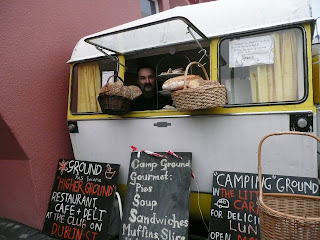This article appears also in the lastest edition of The Lyttelton News which comes out once a month as part of the Akaroa Mail. The Lyttelton News is one of the projects that are driven by Project Lyttelton.
Derry in Northern Ireland could hold the answer for our community as to how our town and city moves forward in its regeneration following the earthquakes.
There are many parallels between Christchurch’s and Derry’s situations. Both were ravaged; one my nature, one by war. There was widespread destruction of both buildings and lives. The people felt disempowered – in New Zealand by the creation of a top down solution by the government appointed CERA and in Northern Ireland by Direct Rule at the time (the Thatcher Government).Just as Christchurch has a divide between east and west (affected and not so affected), Derry was divided by the River Foyle.
Derry was in a war zone, there were no communications, but at the same time others were wanting to raise families and work. The local council was in disarray. Rather than being directed from London the people of Derry craved a new way with community based workers and activities. They recognised that it was OK to be angry and complain but that it had to take them in a positive direction.
What Derry has managed to create over the last 15 years is inspirational.
Conal McFeely who has been engaged in the whole Derry process since its inception, spoke recently with community members in Christchurch. This gathering of people, keen to use our earthquake situation as an opportunity, learning from what has worked elsewhere in the world in similar situations, were interested to hear the Northern Ireland story and to see the possible ramifications for Christchurch.
Conal McFeely sees our present situation as a chance for the social sector to take a leadership role in regeneration. He described the mechanisms by which Derry did a huge turn around by engaging the local citizens.
In Derry there was a range of social partners, the community sector was quite strong.
Also there were the two main churches, Church of Ireland and Catholic. They had two dynamic bishops who were both interested in the people, not politics. They acted as the champions of the process.
The Trade Unions were also seen as one of the vehicles for change.
The sector got together and recognised that they needed to establish a structure to move forward on the task of urban regeneration. A Trust was set up. This was supported by the Local Authority.
Then another social enterprise – the Credit Unions - became involved giving access to capital. This became a self help situation; people doing things for themselves.
The first task for the Trust was to identify what land was owned by the public sector. There was concern that if land lay derelict, it would be moved on and used for development, an asset stripping of the people’s own land.
The next step was recognising that the people have a community of knowledge. Every household, every business and every young person in Derry, population 108,000, were and still are consulted. There was a demystifying of all jargon. Questions were asked. Was it possible to acquire land, how do you access resources from the government? This was a huge task, a “tall order” said Conal as there was a history of non engagement in the community.
So they started small, going for the creation of a community hub. They identified one destroyed building that was owned by the public sector and using resources such as unemployed people and recycled materials got things started. People began to rally around that one. The regeneration process was underway. They created a craft village in the main street with micro businesses on the ground floor.
This started to gain everyone’s confidence and to attract government support. Larger projects followed. The Tower Museum was the result of clever community sector thinking. The land was given to the Trust, this was used as the community owned asset that attracted government grants (heritage, lotteries) and a major European grant. The Tower Museum was built by people who had been long term unemployed.Other pieces of land became available, the residents became shareholders in their own regeneration.
The Calgach Centre is a big community and conference centre. Adjacent the city’s first hotel built in 25 years. It was constructed and rented to a hotel chain. Rent from that went into new projects. One of the Credit Unions built with its own resources its head office in Derry. All of the major amenities in the city are now owned by the community. The city won the European ‘best practice of neighbourhood renewal’ award. Recently Derry won the cultural capital of the UK award.Conal MeFeely talks about renewal, revival and regeneration as opposed to rebuilding and recovery. He sees that by bringing all the social sector people together - community groups, small businesses, progressive trade unions, local champions, credit unions and establishing a structure and a vision; identifying public land ownership; creating a hub for, by and with the community – all this creating a new movement, one where social enterprise becomes the vehicle of transformation. Not a top down approach but a process that engages the citizens. As a result of all this learning from Derry’s experience, those who attended the meeting are talking with all their networks, the first stage in gathering the community sector together. Identification of land ownership is the next urgent step.
written by Margaret Jefferies, chair of Project Lyttelton: www.lyttelton.net.nz


















